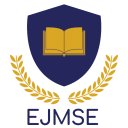Research Article
Numerical Literacy and Math Self-Concept: Children-Friendly Learning in Inclusive Elementary Schools
Danuri ,
S. B. Waluya
,
S. B. Waluya  ,
Sugiman
,
Sugiman ,
Y.L. Sukestiyarno
,
Y.L. Sukestiyarno
Article Metrics
Views
242
Downloads
160
Citations
Crossref
0
Danuri, Waluya SB, Sugiman, Sukestiyarno Y. Numerical literacy and math self-concept: children-friendly learning in inclusive elementary schools. . 2023;4(1):19-27. doi: 10.12973/ejmse.4.1.19
Danuri, Waluya, S. B., Sugiman, & Sukestiyarno, Y. (2023). Numerical literacy and math self-concept: children-friendly learning in inclusive elementary schools. European Journal of Mathematics and Science Education, 4(1), 19-27. https://doi.org/10.12973/ejmse.4.1.19
Danuri, S. B. Waluya, Sugiman, and Y.L. Sukestiyarno. "Numerical Literacy and Math Self-Concept: Children-Friendly Learning in Inclusive Elementary Schools," European Journal of Mathematics and Science Education 4, no. 1 (2023): 19-27. https://doi.org/10.12973/ejmse.4.1.19
Danuri, Waluya, SB Sugiman, & Sukestiyarno, 2023, 'Numerical literacy and math self-concept: children-friendly learning in inclusive elementary schools', European Journal of Mathematics and Science Education, vol. 4, no. 1, pp. 19-27. Danuri, et al. "Numerical Literacy and Math Self-Concept: Children-Friendly Learning in Inclusive Elementary Schools." European Journal of Mathematics and Science Education, vol. 4, no. 1, 2023, pp. 19-27, https://doi.org/10.12973/ejmse.4.1.19.
Abstract
Numerical literacy refers to the knowledge and ability to use various numbers and basic mathematical symbols to solve problems, while math self-concept means the assessment of students’ skills, abilities, enjoyment, and interest in the subject. However, children with special needs and normal students in inclusive Elementary Schools are yet to sufficiently acquire learning that accommodates literacy and maths self-concept. This causes a need for the implementation of a children-friendly learning process. Therefore, this study aimed to identify the factors influencing the numeracy level and math self-concept, and also explore the obstacles in implementing children-friendly learning in order to facilitate students’ abilities. A qualitative method was applied because of in-depth data exploration regarding children with special needs, while the utilized instruments include tests, questionnaires, and interviews. Both the data collected and the analysis are qualitative, which are obtained through excavation, identification, and description. Consequently, this paper was able to (a) describe the factors influencing the numeracy level and math self-concept in inclusive elementary schools; (b) explore the barriers to implementing children-friendly learning; and (c) identify the relationship between students’ numeracy and math self-concept.
Keywords: Children-friendly learning, inclusive elementary school, math self-concept, numerical literacy.
References
Chatwattana, P. (2021). Massive open online courses model with self-directed learning to enhance digital literacy skills. International Journal of Engineering Pedagogy, 11(5), 122–137. https://doi.org/10.3991/IJEP.V11I5.22461
Erdogan, F., & Sengul, S. (2014). A study on the elementary school students’ mathematics self concept. Procedia - Social and Behavioral Sciences, 152, 596–601. https://doi.org/10.1016/j.sbspro.2014.09.249
Fitriani, S., Istaryatiningtias, & Qodariah, L. (2021). A child-friendly school: How the school implements the model. International Journal of Evaluation and Research in Education, 10(1), 273–284. https://doi.org/10.11591/IJERE.V10I1.20765
Genlott, A. A., & Grönlund, Å. (2016). Closing the gaps - Improving literacy and mathematics by ICT-enhanced collaboration. Computers and Education, 99, 68–80. https://doi.org/10.1016/j.compedu.2016.04.004
Gorges, J., Neumann, P., Wild, E., Stranghöner, D., & Lütje-Klose, B. (2018). Reciprocal effects between self-concept of ability and performance: A longitudinal study of children with learning disabilities in inclusive versus exclusive elementary education. Learning and Individual Differences, 61, 11–20. https://doi.org/10.1016/j.lindif.2017.11.005
Griful-Freixenet, J., Struyven, K., & Vantieghem, W. (2021). Exploring pre-service teachers’ beliefs and practices about two inclusive frameworks: Universal Design for Learning and differentiated instruction. Teaching and Teacher Education, 107, Article 103503. https://doi.org/10.1016/j.tate.2021.103503
Han, F. (2017). Comprehension monitoring in Chinese reading among Chinese adolescent readers. Theory and Practice in Language Studies, 7(4), 241-247. https://doi.org/10.17507/tpls.0704.01
Heyder, A., Steinmayr, R., & Kessels, U. (2019). Do teachers' beliefs about math aptitude and brilliance explain gender differences in children's math ability self-concept? Frontiers in Education. https://doi.org/10.3389/feduc.2019.00034
Kao, C. H. (2021). Enriching undergraduate mathematics curriculum with computer science courses. International Journal of Engineering Pedagogy, 11(5), 37–53. https://doi.org/10.3991/IJEP.V11I5.21701
Karahoca, D., Zaripova, Z. F., Bayanova, A. R., Chikileva, L. S., Lyalyaev, S. V., & Baoyun, X. (2022). During the Covid-19 pandemic, students' opinions on distance education in department of engineering. International Journal of Engineering Pedagogy, 12(2), 4-19. https://doi.org/10.3991/ijep.v12i2.29321
Konopko, J. (2015). Unlocking the potential of the smart grid. AIP Conference Proceedings, 1702, Article 070005. https://doi.org/10.1063/1.4938795
Kunwar, R., Shrestha, B. K., & Sharma, L. (2021). Are teachers aware of mathematics learning disabilities? Reflections from basic level schoolteachers of Nepal. European Journal of Educational Research, 10(1), 367–380. https://doi.org/10.12973/eu-jer.10.1.367
Legette, K. B., & Kurtz-Costes, B. (2020). Math track placement and reflected classroom appraisals are related to changes in early adolescents’ math self-concept. Educational Psychology, 41(5), 602–617. https://doi.org/10.1080/01443410.2020.1760212
Lin, P.-Y. (2021). Teachers’ differentiated assessment practices for secondary students with exceptionalities: The more, the better? Journal of Disability Studies, 7(2), 64–74. https://bit.ly/3ZNF81M
Muarifah, A., Rofi’ah, N. H., & Hayati, E. N. (2020). Embodying children-friendly school through Nganggung culture. In D. Priyono, V. Adriany & R. Anggorowati (Eds.), Proceedings of the 1st International Conference on Early Childhood Care Education and Parenting (ICECCEP 2019) (pp. 152–158). Atlantis Press. https://doi.org/10.2991/assehr.k.201205.103
Nurwidodo, N., Amin, M., Ibrohim, I., & Sueb, S. (2020). The role of eco-school program (Adiwiyata) towards environmental literacy of high school students. European Journal of Educational Research, 9(3), 1089-1103. https://doi.org/10.12973/eu-jer.9.3.1089
Riyadi, Syarifah, T. J., & Nikmaturrohmah, P. (2021). Profile of students’ problem-solving skills viewed from Polya’s four-steps approach and elementary school students. European Journal of Educational Research, 10(4), 1625–1638. https://doi.org/10.12973/eu-jer.10.4.1625
Sibaen, N. W. (2022). quantitative literacy and reasoning of freshman students with different senior high school academic background pursuing STEM-related programs. European Journal of Educational Research, 11(1), 231–242. https://doi.org/10.12973/eu-jer.11.1.231
Sugiyono. (2011). Metode penelitian kuantitatif kualitatif dan R&D [Qualitative quantitative research methods and R&D]. Alfabeta Press.
Thomas, S., & Bacon, A. (2013). Stress and affective inductions in addiction research. In J. MacKillop & H. de Wit (Eds.), The Wiley-Blackwell handbook of addiction psychopharmacology (pp. 411–434). Willey. https://doi.org/10.1002/9781118384404.ch15
Zeidmane, A., & Cernajeva, S. (2011). Interdisciplinary approach in engineering education. International Journal of Engineering Pedagogy, 1(1), 36–41. https://doi.org/10.3991/ijep.v1i1.1604




